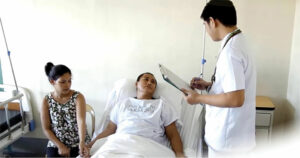A strong and e ff icient primary healthcare system — accessible, timely, and af f ordable — is one of the clearest indicators of a nation’s commitment to public health and well-being. Government investment in this foundational level of care is essential for improving health outcomes and reducing disparities. In many low- and middle-income countries, including the Philippines, access to primary healthcare remains a persistent challenge.
Limited health infrastructure, unequal distribution of medical professionals, and inefficient transportation networks make it difficult for individuals — especially in remote or underserved communities — to seek timely care. However, even amid socioeconomic and geographic constraints, strategic investment and the efficient use of available resources can deliver meaningful improvements in health outcomes. Studies consistently highlight the critical role that distance plays in healthcare utilization.

In Lusaka, Zambia, for instance, 50% of patients visited hospitals within five kilometers of their homes, but only 2% did so if facilities were 30 to 44 kilometers away. A study in the Philippines similarly found that a 10% increase in distance from healthcare facilities was associated with a 2% increase in mortality rates. These findings underscore the urgent need to localize healthcare delivery to ensure equitable access.
Recognizing this need, President Ferdinand R. Marcos, Jr., in his third State of the Nation Address, committed to strengthening the country’s primary healthcare system, particularly in underserved and remote areas.
Key to this effort is the establishment of primary care facilities and the deployment of mobile clinics across provinces. Under the leadership of Health Secretary Teodoro Herbosa, and with support from local government units and legislators, the Department of Health has rolled out over 30 Bagong Urgent Care and Ambulatory Service (BUCAS) Centers nationwide. These intermediate-level health facilities aim to bridge the gap between community health centers and hospitals by offering urgent and ambulatory services seven days a week.
Each BUCAS Center is equipped to provide a wide range of services, including minor surgeries, reproductive healthcare, and laboratory diagnostics. Plans are underway to expand offerings to include ophthalmology, orthopedics, pediatrics, dentistry, radiology, and pharmacy services. Complementing these fixed-site facilities are 83 modern Mobile Primary Care Facilities (MPCFs), procured for deployment in geographically isolated and disadvantaged areas (GIDAs).
Each mobile clinic is equipped with X-ray, ultrasound, laboratory equipment, a telemedicine kit, and essential utilities, ensuring that essential health services can reach even the most remote communities. Meanwhile, the Philippine Health Insurance Corp., better known as PhilHealth, has bolstered its financial protection programs.
Benefit packages for acute stroke and pneumonia have been increased to P76,000 and P90,000, respectively, while the breast cancer benefit has been significantly expanded from P100,000 to P1.4 million. Additional enhancements have been made for colon, lung, liver, ovarian, and prostate cancers — reflecting a strong push for better support for patients with critical illnesses.
The research-based pharmaceutical industry supports these government efforts to revitalize primary healthcare, recognizing it as the foundation for delivering essential health programs. Expanding access to life-saving medicines, vaccines, diagnostics, and essential health information at the primary healthcare level remains a key priority for the biopharmaceutical industry. Beyond its efforts to expand access to medicines and vaccines, the PHAPCares Foundation continues to drive its mission of promoting sustainable healthcare and social development through three innovative partnerships.
These initiatives are focused on strengthening primary healthcare, empowering youth through health advocacy, and controlling neglected tropical diseases, bringing meaningful benefits to communities across the country. One such partnership is with Astellas, which is helping rebuild the One Bonuan Satellite Health Center in Dagupan City. Astellas is supporting the construction of a Barangay Health Station in a GIDA in La Union, which was previously devastated by a typhoon, to ensure better service delivery in underserved areas.
In another initiative, the “Healthy Youth, Healthy Future Project” with AstraZeneca aims to improve the well-being of over 30,000 adolescents in Iloilo. The program addresses pressing health challenges such as teenage pregnancy, HIV/AIDS, mental health, and non-communicable diseases like hypertension and diabetes, empowering young people to take control of their health. Meanwhile, a collaboration with Merck targets the control of schistosomiasis and soil-transmitted helminthiasis in Agusan del Sur.
This initiative focuses on improving water, sanitation, and hygiene practices while strengthening disease diagnosis, treatment, and community-based health interventions to reduce morbidity and prevent further transmission. A strong primary care system enables life-course approaches to prevention, early detection, treatment, and follow-up. However, for such a system to be truly resilient and responsive, it must be matched by long-term domestic financing and sustained multisectoral collaboration.
By strengthening the pillars of primary healthcare today, we can ensure that every Filipino has a better chance at a healthier tomorrow. Teodoro B. Padilla is the executive director of Pharmaceutical and Healthcare Association of the Philippines or PHAP which represents the biopharmaceutical medicines and vaccines industry in the country.
Its members are in the forefront of research and development efforts for COVID-19 and other diseases that affect Filipinos..
Health

Building a resilient primary healthcare system for the Philippines

A strong and efficient primary healthcare system — accessible, timely, and affordable — is one of the clearest indicators of a nation’s commitment to public health and well-being. Government investment in this foundational level of care is essential for improving health outcomes and reducing disparities. In many low- and middle-income countries, including the Philippines, access [...]















